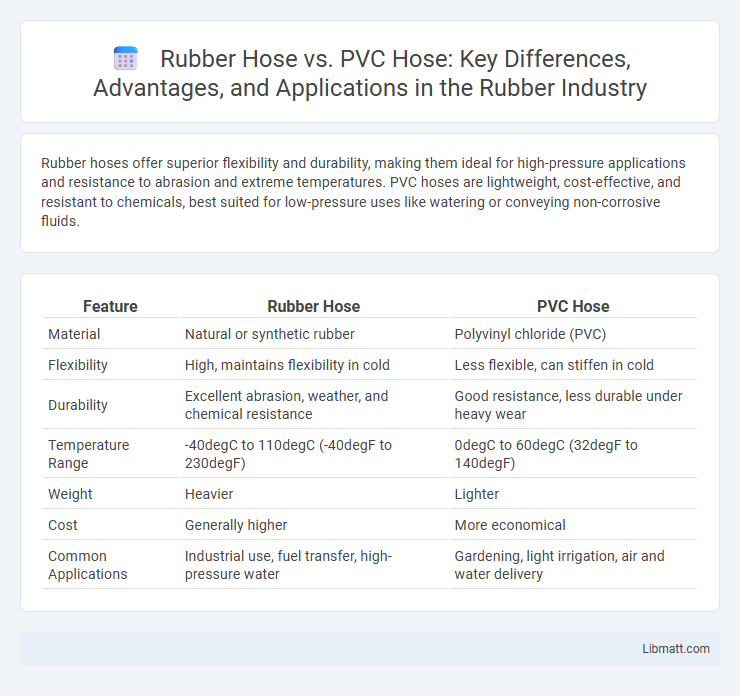Rubber hoses offer superior flexibility and durability, making them ideal for high-pressure applications and resistance to abrasion and extreme temperatures. PVC hoses are lightweight, cost-effective, and resistant to chemicals, best suited for low-pressure uses like watering or conveying non-corrosive fluids.
Table of Comparison
| Feature | Rubber Hose | PVC Hose |
|---|---|---|
| Material | Natural or synthetic rubber | Polyvinyl chloride (PVC) |
| Flexibility | High, maintains flexibility in cold | Less flexible, can stiffen in cold |
| Durability | Excellent abrasion, weather, and chemical resistance | Good resistance, less durable under heavy wear |
| Temperature Range | -40degC to 110degC (-40degF to 230degF) | 0degC to 60degC (32degF to 140degF) |
| Weight | Heavier | Lighter |
| Cost | Generally higher | More economical |
| Common Applications | Industrial use, fuel transfer, high-pressure water | Gardening, light irrigation, air and water delivery |
Introduction to Rubber Hose and PVC Hose
Rubber hoses offer exceptional flexibility, durability, and resistance to abrasion, making them ideal for high-pressure applications and harsh environments. PVC hoses are lightweight, cost-effective, and offer good chemical resistance, commonly used for irrigation and low-pressure fluid transfer. Understanding your specific needs will help determine whether a rubber hose or PVC hose is best suited for your application.
Material Composition and Manufacturing
Rubber hoses are made from natural or synthetic rubber compounds, offering high flexibility, durability, and resistance to abrasion and extreme temperatures due to their elastic polymer structure. PVC hoses consist of polyvinyl chloride resin combined with plasticizers, making them lightweight, corrosion-resistant, and cost-effective but less flexible and heat-resistant compared to rubber hoses. Manufacturing of rubber hoses involves vulcanization to enhance strength and elasticity, whereas PVC hoses are produced through extrusion and calendaring processes that create a rigid yet flexible tubing structure suitable for various industrial and domestic applications.
Flexibility and Handling Differences
Rubber hoses offer superior flexibility and shock absorption, making them ideal for applications requiring frequent bending and maneuvering. PVC hoses, while lighter and more cost-effective, tend to be stiffer and less flexible, reducing ease of handling in tight spaces. The inherent elasticity of rubber materials provides enhanced durability and resistance to kinking compared to the more rigid PVC composition.
Durability and Longevity Comparison
Rubber hoses offer superior durability and longevity due to their flexibility and resistance to abrasion, UV rays, and extreme temperatures, making them ideal for heavy-duty applications. PVC hoses tend to be lighter and more affordable but are less resistant to cracking and wear over time, especially under harsh environmental conditions. When choosing between the two, your priority should be long-term performance and resilience, where rubber hoses generally excel.
Temperature and Weather Resistance
Rubber hoses excel in temperature and weather resistance, maintaining flexibility and durability in extreme heat and cold, typically ranging from -40degF to 180degF (-40degC to 82degC). PVC hoses have a narrower temperature tolerance, usually between 32degF and 140degF (0degC to 60degC), and may become brittle or crack under harsh weather conditions. Your choice should consider the operating environment to ensure optimal hose performance and longevity.
Chemical and Abrasion Resistance
Rubber hoses offer superior chemical resistance against oils, acids, and alkalis, making them ideal for industrial applications involving harsh substances. PVC hoses excel in abrasion resistance due to their tough outer layer, which withstands wear and tear in construction and gardening tasks. Your choice should consider the specific chemicals involved and the level of mechanical abrasion the hose will endure to ensure optimal durability and performance.
Weight and Portability Factors
Rubber hoses are generally heavier due to their dense material composition, which provides durability but reduces portability for extended use or transport. PVC hoses are lightweight, making them easier to carry and maneuver, especially for tasks requiring frequent movement or storage in tight spaces. The weight difference significantly impacts user fatigue and convenience, with PVC being preferable for portability while rubber excels in heavy-duty applications.
Common Applications and Uses
Rubber hoses excel in applications requiring flexibility, durability, and resistance to abrasion, commonly used in automotive, construction, and industrial machinery for fuel transfer, air and water conveyance, and hydraulic systems. PVC hoses are favored in agricultural irrigation, gardening, and light chemical transport due to their lightweight nature, resistance to corrosion, and lower cost. Both hose types find essential roles in fluid transport, but rubber hoses are preferred for heavy-duty or high-pressure environments, while PVC hoses serve well in moderate-pressure and general-purpose tasks.
Cost Analysis: Rubber Hose vs PVC Hose
Rubber hoses typically have a higher initial cost than PVC hoses due to their durability and resistance to abrasion, chemicals, and high temperatures. PVC hoses are more cost-effective for light-duty applications, offering lower upfront expenses but may require more frequent replacement or maintenance. When evaluating cost analysis, consider the total cost of ownership, including lifespan, maintenance needs, and application environment, to determine the most economical option between rubber and PVC hoses.
Choosing the Right Hose for Your Needs
Selecting between a rubber hose and a PVC hose depends on your specific application and environmental conditions. Rubber hoses offer superior flexibility, durability, and resistance to abrasion and extreme temperatures, making them ideal for heavy-duty and industrial use. PVC hoses are lightweight, cost-effective, and suitable for lighter tasks such as gardening or water delivery, providing a practical choice if you prioritize budget and ease of handling.
Rubber Hose vs PVC Hose Infographic

 libmatt.com
libmatt.com